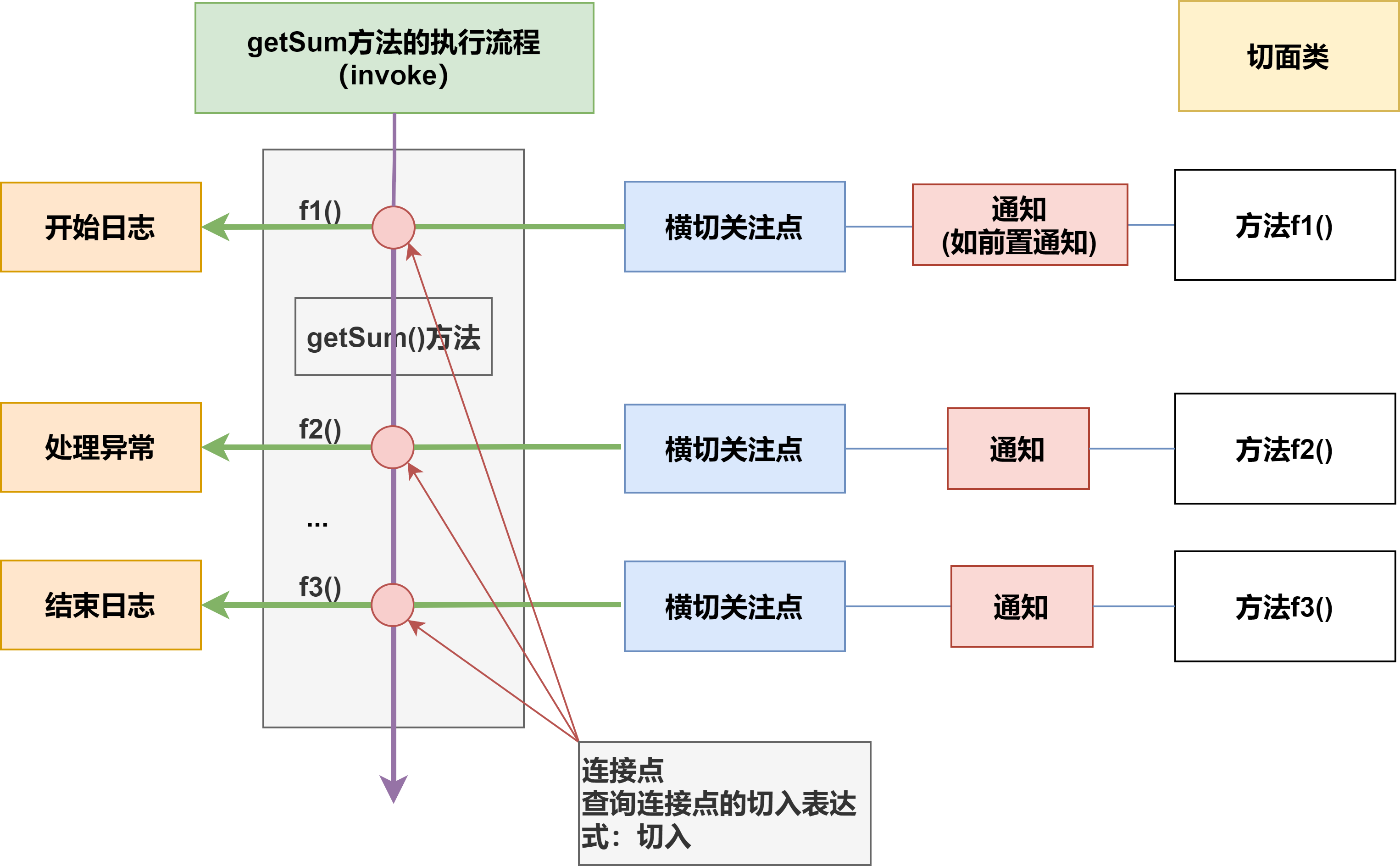AOP-02
4.问题提出
在上一篇的MyProxyProvider类中,我们的输出语句功能比较弱,在实际开发中,我们希望是以一个方法的形式,嵌入到真正执行的目标方法前,怎么办?

1.使用土方法解决
需求分析:使用土方法解决前面的问题,后面使用spring的aop组件完成
改进MyProxyProvider:
主要是对前置/返回/异常/最终通知的代码进行封装,封装到不同的方法中进行调用。
package com.li.aop.proxy3; import java.lang.reflect.InvocationHandler; import java.lang.reflect.Method; import java.lang.reflect.Proxy; import java.util.Arrays; /** * @author 李 * @version 1.0 * 返回一个动态代理对象,可以执行被代理的对象的方法 */ public class MyProxyProvider { //定义要执行的目标对象,该对象需要实现 SmartAnimal接口 private SmartAnimal target_animal; //构造器 public MyProxyProvider(SmartAnimal target_animal) { this.target_animal = target_animal; } //定义一个方法,在目标对象执行前执行 public void before(Method method, Object[] args) { System.out.println("before-方法执行开始-日志-方法名-" + method.getName() + "-参数 " + Arrays.toString(args));//AOP的角度看,是一个横切关注点-前置通知 } //定义一个方法,在目标对象执行后行 public void after(Method method, Object result) { System.out.println("after-方法执行正常结束-日志-方法名-" + method.getName() + "-结果 result = " + result);//也是一个横切关注点-返回通知 } //定义方法返回代理对象,该代理对象可以执行目标对象 public SmartAnimal getProxy() { //(1)先得到类加载器对象 ClassLoader classLoader = target_animal.getClass().getClassLoader(); //(2)得到要执行的目标对象的接口信息 Class<?>[] interfaces = target_animal.getClass().getInterfaces(); //(3)使用匿名内部类 创建 InvocationHandler对象 InvocationHandler invocationHandler = new InvocationHandler() { @Override public Object invoke(Object proxy, Method method, Object[] args) throws Throwable { Object result = null; try { before(method, args); //使用反射真正调用方法 result = method.invoke(target_animal, args); after(method, result); } catch (Exception e) { //如果反射出现异常,就会进入到catch块 System.out.println("方法执行异常-日志-方法名" + method.getName() + "-异常类型=" + e.getClass().getName());//横切关注点-异常通知 e.printStackTrace(); } finally {//无论是否出现异常,最终都会执行到 finally{} //也是一个横切关注点-最终通知 System.out.println("方法最终结束-日志-方法名-" + method.getName()); } return result; } }; //创建代理对象 SmartAnimal proxy = (SmartAnimal) Proxy.newProxyInstance(classLoader, interfaces, invocationHandler); return proxy; } } 2.对土方法进行解耦-开发简易的AOP类
上面的代码因为前后置等处理方法都写在同一个类中,造成代码耦合度高的问题。因此,更好的解决方法是新建一个类MyAOP,在该类中进行处理方法的编写,然后在MyProxyProvider类中调用该类的方法。
MyAOP类:
package com.li.aop.proxy3; import java.lang.reflect.Method; import java.util.Arrays; /** * @author 李 * @version 1.0 * 自己写的一个极简AOP类 */ public class MyAOP { //定义一个方法,在目标对象执行前执行 public static void before(Method method, Object[] args) { System.out.println("MyAOP-方法执行开始-日志-方法名-" + method.getName() + "-参数 " + Arrays.toString(args));//前置通知 } //定义一个方法,在目标对象执行后行 public static void after(Method method, Object result) { System.out.println("MyAOP-方法执行正常结束-日志-方法名-" + method.getName() + "-结果 result = " + result);//返回通知 } } 3.再次分析-提出Spring AOP
使用上面的办法仍存在一些问题:
- 不够灵活:假设被代理对象有很多方法,而我们只想仅对其中一个方法进行处理,当前的代码还不能实现这个需求
- 复用性差:假如有一个新的接口USBInterface,Phone类实现了这个接口,现在我们想要Phone类去调用之前MyAOP中的方法。但MyAOP类的方法是根据之前的SmartAnimal接口的方法写的,因此不能很好的适用于新的接口及其实现类
- 硬编码:没有注解和反射的支撑
5.AOP的基本介绍
1.什么是AOP?
官方文档:核心技术 (spring.io)
AOP全称:aspect oriented programming,即面向切面编程。
AOP 是一种编程思想,是面向对象编程(OOP)的一种补充。面向对象编程将程序抽象成各个层次的对象,而面向切面编程是将程序抽象成各个切面。
2.AOP和OOP的区别:
OOP 针对业务处理过程的实体及其属性和行为进行抽象封装,以获得更加清晰高效的逻辑单元划分。
而 AOP 则是针对业务处理过程中的切面进行提取,它所面对的是处理过程中的某个步骤或阶段,以获得逻辑过程中各部分之间低耦合性的隔离效果。
这两种设计思想在目标上有着本质的差异:
面向目标不同:简单来说 OOP 是面向名词领域,AOP 面向动词领域。
思想结构不同:OOP 是纵向结构,AOP 是横向结构。
注重方面不同:OOP 注重业务逻辑单元的划分,AOP 偏重业务处理过程中的某个步骤或阶段。

aop通过动态代理+反射的方式,对被代理对象的方法进行调用。
这个被代理对象的方法的调用过程,会拆分成几个横切关注点:
- 方法调用前
- 方法调用
- 方法调用后
- 异常位置(catch块)
- 方法最终调用位置(finally块)
如下,切面类C的不同方法f1……fn可以在不同类A,B......的方法m1,m2......执行的过程中,在方法的不同横切关注点任意切入/调用。
即切面类的任意方法可以在任意类的任意方法执行的过程中,在该方法的不同横切关注点任意切入。



3.AOP的实现方式
- 基于动态代理的方式[内置AOP实现]
- 使用框架aspectj来实现
6.AOP编程快速入门
6.1基本说明
这里使用框架aspectj来实现:
-
引入核心的aspect包
-
在切面类中声明通知方法
- 前置通知:@Before
- 返回通知:@AfterReturning
- 异常通知:@AfterThrowing
- 后置通知:@After
- 环绕通知:@Around
-
五种通知和前面写的动态代理类方法的对应关系:

6.2快速入门实例
使用aop编程的方式,来实现手写的动态代理案例的效果。以上一篇的3.1为例子:
需求说明:有一个SmartAnimal接口,可以完成简单的加减法,要求在执行getSum()和getSub()时,输出执行前、执行过程、执行后的日志输出,请思考如何实现
1.导入AOP编程需要的包

2.代码实现
2.1SmartAnimal接口:
package com.li.aop.aspectj; /** * @author 李 * @version 1.0 */ public interface SmartAnimal { //求和 float getSum(float a, float b); //求差 float getSub(float a, float b); } 2.2SmartDog实现类:
package com.li.aop.aspectj; import org.springframework.stereotype.Component; /** * @author 李 * @version 1.0 */ //使用component注解,当spring容器启动时,将SmartDog注入容器 @Component public class SmartDog implements SmartAnimal { @Override public float getSum(float a, float b) { float result = a + b; System.out.println("方法内部打印 result = " + result); return result; } @Override public float getSub(float a, float b) { float result = a - b; System.out.println("方法内部打印 result = " + result); return result; } } 2.3SmartAnimalAspect切面类:
package com.li.aop.aspectj; import org.aspectj.lang.JoinPoint; import org.aspectj.lang.Signature; import org.aspectj.lang.annotation.*; import org.springframework.stereotype.Component; import java.util.Arrays; /** * @author 李 * @version 1.0 * 切面类,类似之前写的 MyProxyProvider,但是功能比它强大得多 */ @Aspect //表示一个切面类[底层自动注入切面编程的支撑(动态代理+反射+动态绑定)] @Component //注入切面类到ioc容器 public class SmartAnimalAspect { /** * 前置通知 * 1.@Before表示前置通知,即在我们的目标对象执行方法前执行 * 2.value = "execution(public float com.li.aop.aspectj.SmartDog.getSum(float, float))" * 指定切入到哪个类的哪个方法 形式为:execution(访问修饰符 返回类型 全类名.方法名(形参列表)) * 3.f1方法就是一个切入方法,方法名随意 * 4.JoinPoint joinPoint 在底层执行时,由AspectJ切面框架,给切入方法传入joinPoint连接点对象 * 通过切面方法,可以获取你想要的信息 * * @param joinPoint */ @Before(value = "execution(public float com.li.aop.aspectj.SmartDog.getSum(float, float))") public void f1(JoinPoint joinPoint) { //通过连接点对象joinPoint 拿到方法签名 Signature signature = joinPoint.getSignature(); System.out.println("切面类f1()-方法执行开始-日志-方法名-" + signature.getName() + "-参数 " + Arrays.toString(joinPoint.getArgs())); } //返回通知:把 f2方法切入到目标对象方法正常执行完毕后的位置 @AfterReturning(value = "execution(public float com.li.aop.aspectj.SmartDog.getSum(float, float))") public void f2(JoinPoint joinPoint) { Signature signature = joinPoint.getSignature(); System.out.println("切面类f2()-方法执行正常结束-日志-方法名-" + signature.getName()); } //异常通知:把 f3方法切入到目标对象方法出现异常后的catch块位置 @AfterThrowing(value = "execution(public float com.li.aop.aspectj.SmartDog.getSum(float, float))") public void f3(JoinPoint joinPoint) { Signature signature = joinPoint.getSignature(); System.out.println("切面类f3()-方法执行异常-日志-方法名-" + signature.getName()); } //最终通知:把 f4方法切入到目标对象方法执行后的位置,无论有无出现异常都会执行 @After(value = "execution(public float com.li.aop.aspectj.SmartDog.getSum(float, float))") public void f4(JoinPoint joinPoint) { Signature signature = joinPoint.getSignature(); System.out.println("切面类f4()-方法最终执行完毕-日志-方法名-" + signature.getName()); } } 2.4配置容器文件beans07.xml:
<?xml version="1.0" encoding="UTF-8"?> <beans xmlns="http://www.springframework.org/schema/beans" xmlns:xsi="http://www.w3.org/2001/XMLSchema-instance" xmlns:context="http://www.springframework.org/schema/context" xmlns:aop="http://www.springframework.org/schema/aop" xsi:schemaLocation="http://www.springframework.org/schema/beans http://www.springframework.org/schema/beans/spring-beans.xsd http://www.springframework.org/schema/context https://www.springframework.org/schema/context/spring-context.xsd http://www.springframework.org/schema/aop https://www.springframework.org/schema/aop/spring-aop.xsd"> <!--配置自动扫描的包--> <context:component-scan base-package="com.li.aop.aspectj"/> <!--一定要开启基于注解的 AOP 功能--> <aop:aspectj-autoproxy/> </beans> 2.5测试类:
package com.li.aop.aspectj; import org.springframework.context.ApplicationContext; import org.springframework.context.support.ClassPathXmlApplicationContext; import org.testng.annotations.Test; /** * @author 李 * @version 1.0 * 测试类 */ public class AopAspectjTest { @Test public void smartDogTestByAspectj() { //得到Spring容器 ApplicationContext ioc = new ClassPathXmlApplicationContext("beans07.xml"); //通过接口类型来获得注入的SmartDog对象(实际上是代理对象proxy) SmartAnimal smartAnimal = ioc.getBean(SmartAnimal.class); //class com.sun.proxy.$Proxy15 //System.out.println("smartAnimal的运行类型=" + smartAnimal.getClass()); smartAnimal.getSum(100, 48); } } 测试结果:

6.3细节说明
-
关于切面类方法命名可以自己规范一下
-
切入表达式的更多配置,比如使用模糊配置
形式为:execution(访问修饰符 返回类型 全类名.方法名(形参列表))
@Before(value = "execution(* com.li.aop.aspect.SmartDog.*(..))") -
下面表示所有访问权限,所有包下所有类的所有方法(前提是基于动态代理的类),都会被执行前置通知方法
@Before(value = "execution(* *.*(..))") -
spring容器开启了基于注解的AOP功能
<aop:aspectj-autoproxy/>,获取注入的对象则需要以接口的类型来获取,因为你注入的对象.getClass()已经是代理类型了! -
spring容器开启了基于注解的AOP功能,也可以通过id来获取注入的对象,但也要转成接口类型来获取。
6.4练习
- 有一个接口USBInterface,该接口有一个方法work
- 写出实现子类Phone和Camera
- 写一个切面类,在该切面类中写一个方法(可输出日志信息)等作为前置通知,在Phone和Camera对象执行work方法前调用
- 其他通知,如返回通知,异常通知,后置通知,也可以加入






